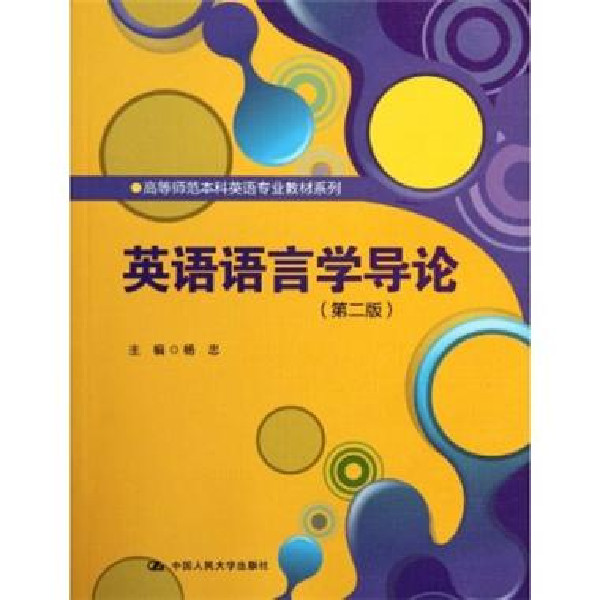基本信息
作者:楊忠
叢書名:高等師範本科英語專業教材系列
出版社:中國人民大學出版社
ISBN:9787300147161
出版日期:2012 年2月
開本:16開
頁碼:232
版次:2-1
內容簡介
每章後安排輔導問題、習題和小課題,幫助解決因語言學理論抽象導致的初學者難以理解以及課後容易遺忘等問題。
目錄
《英語語言學導論(第二版)》
chapter 1 language and linguistics
1.1 the multifaceted nature of language
1.2 features of language
1.3 functions of language
1.4 types of language
1.4.1 natural languages and artificial languages
1.4.2 genetic classification of languages
1.4.3 typological classification of languages
1.5 the evolution of language
1.6 linguistics: the scientific study of language
1.6.1 linguistics as a science
1.6.2 branches of linguistics
1.6.3 schools of linguistics
1.6.4 features of modem linguistics
chapter 2 phonetics: the study of speech sounds
2.1 the study of speech sounds
2.2 the sound-producing mechanism
2.3 phonetic transcription of speech sounds
2.3.1 unit of representation '"'
.2.3.2 phonetic symbols
2.4 description of english consonants
2.5 description of english vowels
2.6 phonetic features and natural classes
chapter 3 phonology: the study of sound systems and patterns
3.1 the study of sound systems and patterns
3.2 phonemes and allophones
3.3 discovering phonemes
3.3.1 contrastive distribution
3.3.2 complimentary distribution
3.3.3 free variation
3.3.4 the discovery procedure
3.4 distinctive features and non-distinctive features
3.5 phonological rules
3.6 syllable structure
3.7 sequence of phonemes
3.8 suprasegmental features
3.8.1 stress
3.8.2 intonation
3.8.3 tone
3.8.4 the functioning of stress and intonation in english
chapter 4 morphology: the study of word structure.
4.1 word, lexeme and morphology
4.2 morpheme: the minimal meaningful unit of language
4.3 root, base and stem
4.4 classification of morphemes
4.4.1 free and bound morphemes
4.4.2 inflectional and derivational morphemes
4.5 formation of english words
4.5.1 derivation
4.5.2 compounding
4.5.3 other types of english word formation
chapter 5 syntax: the analysis of sentence structure
5.1 grammaticality
5.2 knowledge of sentence structure
5.3 different approaches to syntax
5.4 transformational-generative grammar
5.4.1 the goal of a tg grammar
5.4.2 syntactic categories
5.4.3 phrase structure rules
5.4.4 tree diagrams
5.4.5 recursion and the infinitude of language
5.4.6 subcategorization of the lexicon
5.4.7 transformational rules
5.5 systemic-functional grammar
5.5.1 two perspectives of syntactic analysis: chain and choice
5.5.2 the three metafunctions
5.5.3 transitivity: syntactic structure as representation of experience
5.5.4 mood and modality: syntactic structure as representation of interaction.
5.5.5 theme and rheme: syntactic structure as organization of message
chapter 6 semantics: the analysis of meaning
6.1 the study of meaning
6.2 reference and sense
6.2.1 reference
6.2.2 sense
6.3 classification of lexical meanings
6.3.1 referential meaning and associative meaning
6.3.2 types of associative meaning
6.4 lexical sense relations
6.4.1 synonymy
6.4.2 antonymy
6.4.3 homonymy
6.4.4 polysemy
6.4.5 hyponymy
6.4.6 meronymy
6.5 describing lexical meaning: componential analysis
6.6 words and concepts
6.6.1 categorization
6.6.2 prototypes
6.6.3 hierarchies
6.7 semantic relations of sentences
6.8 metaphors
6.8.1 from rhetorical device to cognitive device:
6.8.2 the components of metaphors
6.8.3 features of metaphors
6.9 metonymy
6.9.1 conceptual metonymy
6.9.2 types ofmetonymy
6.9.3 relation between metaphor and metonymy
chapter 7 pragmatics: the analysis of meaning in context
7.1 pragmatics: an overview
7.2 deixis and reference
7.2.1 person deixis
7.2.2 place deixis
7.2.3 time deixis
7.2.4 discourse deixis
7.2.5 social deixis
7.2.6 deictic center
7.3 speech acts
7.3.1 the constative-performative dichotomy
7.3.2 the trichotomy of speech acts
7.3.3 taxonomy of speech acts
7.3.4 indirect speech acts
7.4 pragmatic presupposition
7.5 cooperation and implica~are
7.5.1 grice's cooperative principle and the four maxims
7.5.2 conversational implicature
7.5.3 conversational implicature and inference
7.6 politeness and the politeness principle
7.6.1 politeness as a universal phenomenon
7.6.2 the politeness principle
7.6.3 scales of politeness
7.6.4 social variables in politeness
7.6.5 cultural differences in politeness
7.7 hedges
7.7.1 classification of hedges
7.7.2 pragmatic functions of hedges
7.8 the principle of relevance
7.9 conversational structure
chapter 8 text analysis: exploring principles of text construction
8.1 discourse and text
8.2 cohesion and coherence
8.2.1 grammatical cohesion
8.2.2 lexical cohesion
8.2.3 conjunction
8.3 cohesive chains
8.4 discourse markers
8.5 clause relations
8.6 basic textual patterns
8.7 genre and text structure
chapter 9 language and society
9.1 sociolinguistic study of language
9.2 varieties of a language
9.3 grades of formality
9.4 languages in contact
9.5 taboos and euphemisms
9.6 communicative competence
chapter 10 language and culture
10.1 what is culture?
10.2 characteristics of culture
10.3 how is language related to culture?
10.4 sapir-whorf hypothesis
10.5 are linguistic meanings universal?
10.6 the ethnography of communication
10.7 cultural aspect of language teaching and learning
chapter 11 second language acquisition
11.1 what is second language acquisition?
11.2 factors affecting sla
11.2.1 social factors
11.2.2 learner factors
11.3 analyzing learners' language
11.3.1 contrastive analysis
11.3.2 error analysis
11.3.3 the study of interlanguage
11.4 explaining second language acquisition
11.4.1 mentalist explanation of sla
11.4.2 functionalist explanation of sla
11.5 the role of output in sla
chapter 12 linguistics and foreign language teaching
12.1 foreign language teaching as a system
12.2 contribution of linguistics: applications and implications
12.3 linguistic underpinning of syllabus design
12.4 method as integration of theory and practice
12.5 linguistics and language testing
12.6 linguistics in the professional development of language teachers
references
key to exercises
an english-chinese glossary
appendix i the indo-european language family
appendix ii families/groups of languages
appendix iii 語言學學習方法舉要

